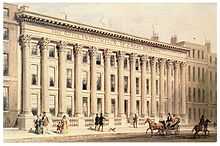Albemarle Street

Albemarle Street is a street in Mayfair in central London, off Piccadilly. It has historic associations with Lord Byron, whose publisher John Murray was based here, and Oscar Wilde, a member of the Albemarle Club, where an insult he received led to his suing for libel and to his eventual imprisonment. It is also known for its art galleries and the Brown's Hotel is located at 33 Albemarle Street.
History
Albemarle Street was built by a syndicate of developers headed by Sir Thomas Bond. The syndicate purchased a Piccadilly mansion called Clarendon House from Christopher Monck, 2nd Duke of Albemarle in 1683 and proceeded to demolish the house and develop the area. At that time the house backed onto open fields and the development of the various estates in Mayfair was just getting underway. The syndicate also built Bond Street and Dover Street.
Albemarle Street was the first one-way street created for the purpose of better traffic flow in London. The decision was taken after a series of lectures by Humphry Davy at the Royal Institution caused gridlock in the capital because of the horrendous queues formed by horsedrawn carriages bringing in the eager audience. Albemarle Street was made a one-way street to avoid further incidents of such congestion.
Occupants
.jpg)
Victor Spencer, 1st Viscount Churchill (1864–1934), a Page of Honour to Queen Victoria and British peer, was born at 32 Albemarle Street.
Anne Lister (1791–1840), a notable Victorian lesbian, stayed at 29 Albemarle Street in rooms owned by Hawkins, who also had premises in Dover Street.[1]
The Albemarle Club was originally in Albemarle Street and relocated to Dover Street nearby before its closure. Oscar Wilde was a member. In 1895, the Marquess of Queensberry left his calling card for Wilde with the infamous note "For Oscar Wilde, posing as a somdomite" (sic). This led to Wilde's failed libel action and subsequent criminal prosecution.
The publisher John Murray was located at 50 Albemarle Street in Victorian times and during the 20th century. Lord Byron's letters were destroyed in the fireplace on the first floor after his death. Sir John Betjeman, the poet and broadcaster was another Murray author.
Frenchman Alexander Grillion opened Grillion's Hotel at No. 7 in 1803. Louis XVIII stayed here in 1814, before his return to France.[2] It was also the meeting place of Grillion's dining club. The Royal Thames Yacht Club was later based here.

The Royal Institution is located at 21 Albemarle Street and forms an imposing backdrop on the street with its row of classical columns on its frontage. The building has been greatly enlarged and redeveloped since 1799 when the Institution was founded, and is now a Grade I listed building. Because of the Institution's popularity (through its scientific lectures), Albemarle Street became London's first one-way street to avoid traffic problems.[3]
The naturalist Thomas Huxley founded the X Club as a dining club meeting for the first time on 3 November 1864 at St George's Hotel, Albemarle Street, with a select membership of nine proponents of the evolutionary "new reformation" in naturalism who supported the ideas of Charles Darwin and became increasingly influential in late 19th century science.
Rev. William Webb Ellis (1806–1872) was an Anglican clergyman who is famous for allegedly being the inventor of Rugby football whilst a pupil at Rugby School. He graduated from Oxford with a BA in 1829 and received his MA in 1831. He entered the Church and became chaplain of St George's Chapel, Albemarle Street, London. Where he published his 'Sermons: Preached in St. George's Chapel, Albemarle Street; to Which Is Added, an Essay On the Prophecies Relative to Christ'.
In the 1950s, Ernö Goldfinger's design for two office buildings at 45–46 Albemarle Street was praised for its sensitivity to the surrounding Georgian architecture.[4]
Galleries
.jpg)
The street is host to a number of art galleries. These include:
- Connaught Brown, 2 Albemarle Street
- The Archeus Gallery, 3 Albemarle Street
- Marlborough Fine Art, 6 Albemarle Street
- Phillips de Pury & Company, 25–26 Albemarle Street
- Mazzoleni Art, 27 Albemarle Street
- The Grosvenor Gallery, 37 Albemarle Street
- John Martin of London, 38 Albemarle Street
- The Belgravia Gallery, 45 Albemarle Street
- The Albemarle Gallery, 49 Albemarle Street
- Faggionato Fine Arts, 49 Albemarle Street (first floor)
- W. H. Patterson Fine Arts, 19 Albemarle Street
Location
To the south-east, the street adjoins Piccadilly. Running parallel with Albemarle Street to the south-west is Dover Street and to the north-east are New Bond Street and Old Bond Street. The nearest tube station is Green Park.
See also
References
- ↑ Anne Lister in London 1819-1839
- ↑ Geraldine Edith Mitton (1903). Mayfair, Belgravia, and Bayswater.
- ↑ James, Frank. "Making traffic history - Albemarle Street". The Royal Institution of Great Britain. Retrieved 30 December 2012.
- ↑ Ernö Goldfinger / Designing Modern Britain — Design Museum